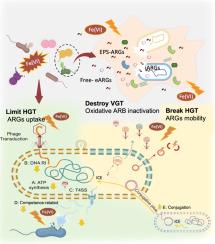高铁酸盐(Fe(VI))对抗生素耐药基因的双途径抑制:厌氧消化污泥的氧化失活和遗传迁移障碍
IF 12.4
1区 环境科学与生态学
Q1 ENGINEERING, ENVIRONMENTAL
引用次数: 0
摘要
抗生素耐药基因(ARGs)和抗生素耐药细菌(ARB)是威胁公众健康的新兴环境污染物,迫切需要有效的控制策略。高铁酸盐(Fe(VI))是一种强效环保型氧化剂,在这方面具有很大的潜力。本研究系统地评估了铁(VI)在厌氧消化污泥中减轻ARGs和ARB的效果,特别关注阐明铁(VI)通过垂直基因转移(VGT)和水平基因转移(HGT)影响ARGs传播的潜在机制。结果表明,20和60 mg/g-TS的Fe(VI)剂量分别降低了9.75%和19.12%的ARGs,而高剂量的ARB失活率高达24.7%。优先去除致病性ARB,如大肠杆菌和索内志贺氏菌,丰度分别降低63.7%和28.0%。在机械上,厌氧消化污泥中的Fe(VI)引起细菌细胞的结构破坏,如细胞外聚合物质减少29%和细胞膜通透性增加23.7%所示。随后,还观察到细胞内ARGs向细胞外环境的显著释放,在细胞外环境中它们可能受到Fe(VI)的降解。这种氧化杀灭导致观察到的ARB减少,从而限制了arg的VGT。此外,Fe(VI)通过降低ARGs的迁移潜力来损害其HGT,这反映在与可移动遗传元件共出现的减少上。同时,污泥菌对DNA的摄取和重组能力显著降低,相关功能基因丰度下降9.8%。这些发现表明,Fe(VI)通过靶向两种主要传播途径有效抑制ARGs的传播。它抑制了VGT,从而减少了ARB在种群内的遗传,并限制了HGT,抑制了移动arg在胜任物种中的传播。通过破坏这两个关键途径,Fe(VI)显示出作为减缓ARGs在污泥系统中传播的有效策略的强大潜力。本文章由计算机程序翻译,如有差异,请以英文原文为准。

Dual-Pathway Inhibition of Antibiotic Resistance Genes by Ferrate (Fe(VI)): Oxidative Inactivation and Genetic Mobility Impairment in Anaerobically Digested Sludge
Antibiotic resistance genes (ARGs) and antibiotic resistant bacteria (ARB) are emerging environmental contaminants that threaten public health, highlighting the urgent need for effective control strategies. Ferrate (Fe(VI)), a strong and eco-friendly oxidant, shows great potential for this purpose. This study systematically evaluated the efficacy of Fe(VI) in mitigating ARGs and ARB in anaerobically digested sludge, with a particular focus on elucidating the underlying mechanisms by which Fe(VI) effects ARGs dissemination through both vertical gene transfer (VGT) and horizontal gene transfer (HGT). Result shows that Fe(VI) doses of 20 and 60 mg/g-TS reduce ARGs by 9.75% and 19.12%, respectively, while inactivating up to 24.7% of ARB at the higher dose. Pathogenic ARB, such as Escherichia coli and Shigella sonnei, are preferentially removed, with abundances decrease by 63.7% and 28.0%. Mechanistically, the structural disruption of bacterial cells caused by Fe(VI) in anaerobically digested sludge, as indicated by a 29% reduction in extracellular polymeric substances and a 23.7% increase in cell membrane permeability. Subsequently, a marked release of intracellular ARGs into the extracellular environment is also observed, where they are likely subjected to degradation by Fe(VI). This oxidative killing accounts for the observed ARB decrease, thereby limiting the VGT of ARGs. In addition, Fe(VI) impairs the HGT of ARGs by diminishing their mobility potential, reflected in the reduced co-occurence with mobile genetic elements. Meanwhile, sludge bacterial competence for DNA uptake and recombination is markedly reduced, as evidenced by a 9.8% decline in the abundance of related functional genes. These findings demonstrate that Fe(VI) effectively inhibits the dissemination of ARGs by targeting both primary transmission pathways. It suppresses VGT, thereby reducing the inheritance of ARB within populations, and limits HGT, curbing the spread of mobile ARGs among competent species. By disrupting these two critical routes, Fe(VI) shows strong potential as an effective strategy for mitigating ARGs propagation in sludge systems.
求助全文
通过发布文献求助,成功后即可免费获取论文全文。
去求助
来源期刊

Water Research
环境科学-工程:环境
CiteScore
20.80
自引率
9.40%
发文量
1307
审稿时长
38 days
期刊介绍:
Water Research, along with its open access companion journal Water Research X, serves as a platform for publishing original research papers covering various aspects of the science and technology related to the anthropogenic water cycle, water quality, and its management worldwide. The audience targeted by the journal comprises biologists, chemical engineers, chemists, civil engineers, environmental engineers, limnologists, and microbiologists. The scope of the journal include:
•Treatment processes for water and wastewaters (municipal, agricultural, industrial, and on-site treatment), including resource recovery and residuals management;
•Urban hydrology including sewer systems, stormwater management, and green infrastructure;
•Drinking water treatment and distribution;
•Potable and non-potable water reuse;
•Sanitation, public health, and risk assessment;
•Anaerobic digestion, solid and hazardous waste management, including source characterization and the effects and control of leachates and gaseous emissions;
•Contaminants (chemical, microbial, anthropogenic particles such as nanoparticles or microplastics) and related water quality sensing, monitoring, fate, and assessment;
•Anthropogenic impacts on inland, tidal, coastal and urban waters, focusing on surface and ground waters, and point and non-point sources of pollution;
•Environmental restoration, linked to surface water, groundwater and groundwater remediation;
•Analysis of the interfaces between sediments and water, and between water and atmosphere, focusing specifically on anthropogenic impacts;
•Mathematical modelling, systems analysis, machine learning, and beneficial use of big data related to the anthropogenic water cycle;
•Socio-economic, policy, and regulations studies.
 求助内容:
求助内容: 应助结果提醒方式:
应助结果提醒方式:


